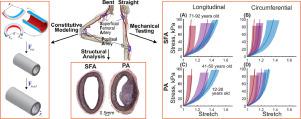Acta Biomaterialia ( IF 9.7 ) Pub Date : 2020-11-21 , DOI: 10.1016/j.actbio.2020.11.025 Majid Jadidi 1 , Sayed Ahmadreza Razian 2 , Eric Anttila 1 , Tyler Doan 2 , Josiah Adamson 2 , Margarita Pipinos 2 , Alexey Kamenskiy 2

|
Peripheral arterial disease differentially affects the superficial femoral (SFA) and the popliteal (PA) arteries, but their morphometric, structural, mechanical, and physiologic differences are poorly understood. SFAs and PAs from 125 human subjects (age 13-92, average 52±17 years) were compared in terms of radii, wall thickness, and opening angles. Structure and vascular disease were quantified using histology, mechanical properties were determined with planar biaxial extension, and constitutive modeling was used to calculate the physiologic stress-stretch state, elastic energy, and the circumferential physiologic stiffness. SFAs had larger radii than PAs, and both segments widened with age. Young SFAs were 5% thicker, but in old subjects the PAs were thicker. Circumferential (SFA: 96→193°, PA: 105→139°) and longitudinal (SFA: 139→306°, PA: 133→320°) opening angles increased with age in both segments. PAs were more diseased than SFAs and had 11% thicker intima. With age, intimal thickness increased 8.5-fold, but medial thickness remained unchanged (620μm) in both arteries. SFAs had 30% more elastin than the PAs, and its density decreased ~50% with age. SFAs were more compliant than PAs circumferentially, but there was no difference longitudinally. Physiologic circumferential stress and stiffness were 21% and 11% higher in the SFA than in the PA across all ages. The stored elastic energy decreased with age (SFA: 1.4→0.4kPa, PA: 2.5→0.3kPa). While the SFA and PA demonstrate appreciable differences, most of them are due to vascular disease. When pathology is the same, so are the mechanical properties, but not the physiologic characteristics that remain distinct due to geometrical differences.
中文翻译:

人体股浅动脉和腘动脉形态、结构、力学和生理特征的比较
外周动脉疾病对股浅动脉 (SFA) 和腘动脉 (PA) 的影响不同,但人们对它们的形态、结构、机械和生理差异知之甚少。对 125 名人类受试者(年龄 13-92,平均 52±17 岁)的 SFA 和 PA 在半径、壁厚和张角方面进行了比较。使用组织学量化结构和血管疾病,通过平面双轴延伸确定机械性能,并使用本构模型计算生理应力-拉伸状态、弹性能和圆周生理刚度。SFA 的半径比 PA 更大,并且两个部分都随着年龄的增长而变宽。年轻受试者的 SFA 较厚,但老年受试者的 PA 较厚。两个节段的周向(SFA:96→193°,PA:105→139°)和纵向(SFA:139→306°,PA:133→320°)张角随着年龄的增长而增加。PA 比 SFA 患病更严重,内膜厚 11%。随着年龄的增长,两条动脉的内膜厚度增加了8.5倍,但中层厚度保持不变(620μm)。SFA 的弹性蛋白比 PA 多 30%,其密度随着年龄的增长而下降约 50%。SFA 在圆周方向上比 PA 更顺应,但在纵向方向上没有差异。所有年龄段的 SFA 中的生理周向应力和刚度均比 PA 中高 21% 和 11%。储存的弹性能随着年龄的增长而减少(SFA:1.4→0.4kPa,PA:2.5→0.3kPa)。虽然 SFA 和 PA 表现出明显的差异,但其中大多数是由血管疾病引起的。当病理学相同时,机械性能也相同,但由于几何差异而保持不同的生理特征。



























 京公网安备 11010802027423号
京公网安备 11010802027423号